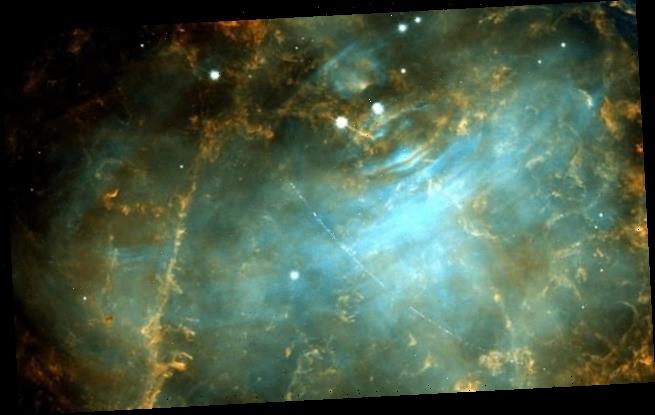NASA reveals incredible galactic ‘photobomb’ image showing an asteroid streaking past the Crab Nebula
- The photograph was originally taken in 2005 in black and white by the Hubble
- A German volunteer has now colourised the image to show greater detail
- Rare to see asteroids like this because they’re small, Europe’s space agency said
A digitally enhanced photograph taken by the Hubble telescope has revealed the Crab Nebula being ‘photobombed’ by an asteroid.
The picture was taken originally in 2005 in black and while and has now been edited by a volunteer who colourised it.
It now shows a stream of white light passing through the colourful gas clouds of the nebula, which is the remnant of a supernova about 5.5 light years across.
Asteroids like this are hard to see and rarely found in photos of areas so vast because they’re so tiny in comparison.
The European Space Agency said: ‘Knowing the date and time when the Hubble images were taken, they can use the trails marked in the pictures to infer asteroids’ positions and velocities.’
The photograph was taken originally in 2005 in black and while and has now been edited by a volunteer and amateur astronomer in Germany – Melina Thévenot – who colourised it. The asteroid 2001 SE101 can be seen streaking in a curved line from the bottom left of the image
Astronomers say they can use photographs which are interrupted by asteroids to learn more about the space rocks hurtling through them.
To this end the European Space Agency (ESA) has set up a project enlisting around 1,900 citizen volunteers to try and find asteroids in satellite images of space.
This one, in the stunning photo of the Crab Nebula, was discovered and edited by astronomy enthusiast Melina Thévenot.
She discovered the trail of an asteroid named 2001 SE101, which was first seen 18 years ago.
In the image it appears as a curved streak that crosses the image from bottom left to top right, near the nebula’s centre.
The Crab Nebula is a the remnant of a supernova – the explosion of a star – in the Taurus constellation.
It got its quirky name from William Parsons, the 3rd Earl of Rosse, who looked at it through a telescope in 1840 and drew it.
His drawing came out looking something like a crab, and the name was born.
The ESA added: ‘Now that volunteers have perused the platform to spot and mark asteroid trails, it is astronomers’ turn to get to work.
‘Knowing the date and time when the Hubble images were taken, they can use the trails marked in the pictures to infer asteroids’ positions and velocities.
‘This means they can determine the orbits and future trajectories of known and previously unknown asteroids with greater precision than before.
‘This knowledge is especially important for near-Earth objects: precisely determining the orbits of these asteroids can help protect our planet from possible impacts.’
WHAT ARE THE DIFFERENT TYPES OF SPACE ROCKS?
An asteroid is a large chunk of rock left over from collisions or the early solar system. Most are located between Mars and Jupiter in the Main Belt.
A comet is a rock covered in ice, methane and other compounds. Their orbits take them much further out of the solar system.
A meteor is what astronomers call a flash of light in the atmosphere when debris burns up.
This debris itself is known as a meteoroid. Most are so small they are vapourised in the atmosphere.
If any of this meteoroid makes it to Earth, it is called a meteorite.
Meteors, meteoroids and meteorites normally originate from asteroids and comets.
For example, if Earth passes through the tail of a comet, much of the debris burns up in the atmosphere, forming a meteor shower.
Source: Read Full Article

